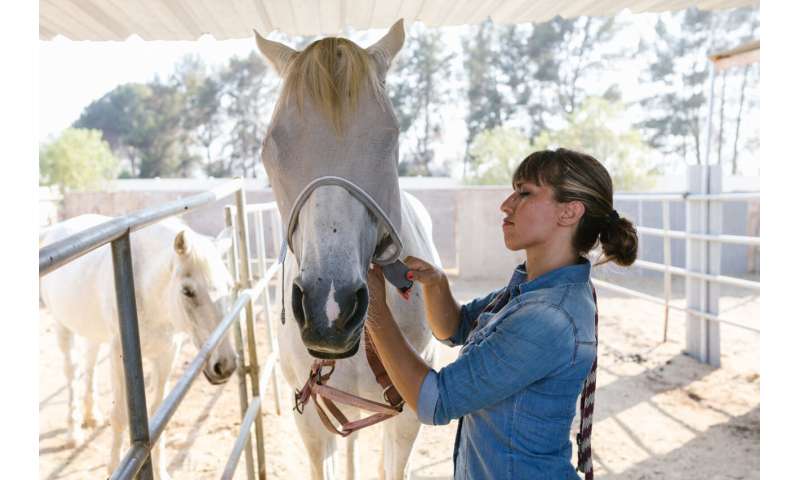We found a way to trap stable flies: their dung preferences helped us

Stable flies (Stomoxys calcitrans) are cold-blooded pests. They feed on the blood of their hosts, which include cattle, camels, horses, dogs and humans. During their feeding they can mechanically transmit viruses and bacteria that cause diseases like West Nile fever, Rift Valley fever and anthrax.
They are found in most countries around the world, and are particularly common where their livestock hosts are farmed. That's because they breed on animal dung.
It's in the breeding process that something surprising emerges about these insects. Our new research shows that female stable flies carefully choose where they lay their eggs to ensure their offspring have the best start in life. It seems the phrase "mother knows best" is true even for flies.
I worked with my Ph.D. student, Steve Baleba, and colleagues from the International Centre of Insect Physiology and Ecology (icipe) in Kenya to find out which types of dung female stable flies preferred for laying their eggs. Knowing this—and the information they use to select it—meant we could explore ways to manage their populations.
We found that the flies favored donkey and sheep dung, so we added the chemicals characteristic of these dung types to traps designed to catch stable flies. This led to a 400% increase in the number of flies trapped. More importantly, the traps caught more female stable flies, large numbers of which were ready to lay eggs and contribute to the next generation. This is a valuable way to reduce fly numbers, protect animals and humans, and control the spread of dangerous diseases.
Pick and choose
We ran a series of experiments to identify preferred dung types for egg-laying by females and to find out why they were chosen and how flies identified the best dung to use.
Stable flies preferred to lay their eggs on donkey and sheep dung rather than the dung of buffalo, camels, elephants, giraffes or zebra—or controls of grass or moist sand.
And their decision had consequences. The larvae that hatched from eggs laid in donkey and sheep dung developed faster and were larger at the end of the larval stage. This meant that the adults were heavier and had larger wings than their peers, which may improve their flight performance.
The improved performance of offspring developing in donkey and sheep dung was closely correlated with higher elemental nitrogen, potassium and zinc content in the dung. In contrast, camel and cow dung—which the flies did not choose—had relatively low concentrations of these elements, and had higher carbon, calcium and water content.
Females also preferred to lay their eggs in dung that was free of competitors and parasites. If dung already contained stable fly larvae—even as few as ten—females laid fewer eggs than on dung with no larvae. Similarly, if dung was already being used by housefly (Musca domestica) larvae, stable flies laid fewer eggs, although this effect was only seen when at least 20 housefly larvae were present. When presented with dung containing parasitic mites (Macrocheles muscaedomesticae), female stable flies also avoided laying eggs.
All these choices benefited the flies' offspring. They were larger, and more of them survived to reach adulthood if they developed without competition. In the absence of parasitic mites, more eggs hatched, more larvae survived to the pupal stage, and adults survived for longer.
Common sense
Stable flies decide where to lay their eggs using sight and smell. Vision is important for avoiding dung containing parasitic mites. We know this because the same number of egg clutches were laid on dung with and without mites when we tested egg-laying in the dark. This surprised us because at least one other fly species (Drosophila hydei) seems to avoid mite infection using their senses of smell and touch.
Either taste or smell is involved with avoiding competition because even in the dark, females laid fewer clutches on dung with competitors. To select between different dung types, female stable flies use their sense of smell. We found that two chemicals characteristic of donkey and sheep dung (β-citronellene and carvone, respectively) encouraged stable flies to lay their eggs on moist sand that had been treated with these chemicals.
We believe that the decision by female stable flies to lay eggs on a preferred dung type is probably hard-wired into their sensory and nervous systems. This is because we found no evidence for females learning to prefer one dung type over another based on the dung they themselves developed in. That said, larvae that accidentally wander away from a preferred dung type have a short-term memory that helps them to return to it.
These results all show that stable flies evolved to find the best conditions for the survival of their offspring.
Armed with this information we were able to test traps using the chemicals β-citronellene and carvone. As I've said, this was hugely successful. The next step is to optimize the blend of these chemicals and commercialize it. We also want to find out which chemicals stable flies use to avoid competition. These could be developed into repellents to protect humans and livestock from stable flies and the diseases they transmit.
This article is republished from The Conversation under a Creative Commons license. Read the original article.![]()
This story is part of Science X Dialog, where researchers can report findings from their published research articles. Visit this page for information about ScienceX Dialog and how to participate.